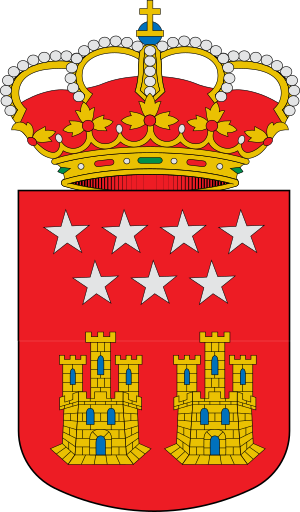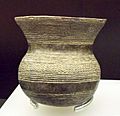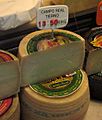Community of Madrid facts for kids
The Community of Madrid (called Comunidad de Madrid in Spanish) is one of Spain's 17 special regions, known as autonomous communities. It's located right in the middle of Spain, on the Iberian Peninsula. The biggest city and its capital is Madrid, which is also the capital of Spain.
Contents
About the Community of Madrid
The Community of Madrid is like a state or a large region within Spain. It has its own government and laws, but it's still part of the country. It's a very important area because it includes Spain's capital city.
Geography and Nature
The region has different types of land. You can find mountains, rivers, and plains.
Mountains and Rivers
To the north and west, there are mountains like the Guadarrama mountain range. The highest peak there is Peñalara. Many rivers flow through the region. These rivers are important for water supply.
Wildlife
The Community of Madrid is home to various animals. You might see the Iberian ibex in rocky areas like La Pedriza. Other animals include the fire salamander and the Algerian sand racer lizard.
Forests and Climate
The climate in Madrid is usually dry in summer. However, some special places, like the Montejo Beech forest, have a unique microclimate. This allows trees and plants that usually grow in colder, wetter places to survive there. This forest is even a World Heritage site. You can also see many olive tree farms, especially in areas like Arganda del Rey.
History of the Region
The area where Madrid is located has a long history. People have lived here for thousands of years.
Ancient Times
Archaeologists have found old tools and pottery from prehistoric times. For example, a special pot from Ciempozuelos shows how people lived long ago. The Romans also had cities here, like Complutum, where you can still see old mosaics.
Medieval Period
During the Middle Ages, many castles and walled towns were built. The city walls of Buitrago del Lozoya are a good example. The Castle of Manzanares el Real is another famous medieval building.
Madrid Becomes Capital
In the 16th century, King Philip II made Madrid the capital of Spain. This made the city and the surrounding region much more important. He also oversaw the building of El Escorial, a huge palace and monastery.
Modern Development
In the past, people in towns like Colmenar de Oreja made large clay pots. Later, big projects like the Canal de Isabel II were built to bring water to the growing city. In the 20th century, factories started to appear, like the Ericsson phone-line factory in Getafe in 1924. The region has grown a lot, with new neighborhoods and businesses.
Economy and Education
The Community of Madrid is a major economic center in Spain.
Businesses and Industry
Many large companies have their main offices here, like Telefónica. The region also has important industries, including aerospace, with an Airbus factory near Getafe. Trade and logistics are also key, with places like the Madrid Trade Fair and the Coslada Dry Port.
Education and Research
Madrid has many schools and universities. There are secondary schools like IES Palas Atenea in Torrejón de Ardoz. Famous universities include the Complutense University of Madrid and the Autonomous University of Madrid. These universities also have important research centers, like the Severo Ochoa Centre for Molecular Biology. The Technical University of Madrid has advanced facilities, including the Magerit supercomputer.
Transport
The region has a very good transport system. Barajas Airport is one of Europe's busiest airports. There are also many train lines, including commuter trains (like in Parla) and high-speed AVE trains from Atocha station.
Culture and Traditions
The Community of Madrid is rich in culture and traditions.
Food and Festivals
Local foods include Cheese from Campo Real. Religious processions, like the Virgen de Gracia procession, are important cultural events.
Diversity
The region is home to people from many different backgrounds and religions. You can find various religious groups, like Hare Krishna followers and Jehovah's Witnesses.
Sports
Sports are very popular. Padel tennis is a common sport played in Madrid.
Public Holidays
One important public holiday is the "2 de Mayo" (May 2nd). It remembers a historical event from 1808.
Images for kids
-
Peñalara: The Guadarrama mountain range's highest peak
-
The Iberian ibex (Capra pyrenaica) in La Pedriza
-
A fire salamander in the laguna de los Pájaros
-
The summer drought is characteristic of the Madrid region's climate. Montejo Beech (part of the transnational Ancient and Primeval Beech Forests of the Carpathians and Other Regions of Europe world heritage site) is a relict forest featuring a particular case of microclimate, allowing for Eurosiberian species that do not grow in the region in normal conditions.
-
Olive tree orchards in Arganda del Rey
-
Prehistoric vessel from Ciempozuelos, exhibited at the National Archaeological Museum of Spain in Madrid
-
A mosaic of the House of Dionysus in Complutum
-
City walls of Buitrago del Lozoya
-
Philip II supervises the works on El Escorial (by Luca Giordano)
-
Manufacturing of big clay pots in Colmenar de Oreja (by Ulpiano Checa)
-
Construction of the bridge-aqueduct of the chasm, part of the Canal de Isabel II in 1854 (by Charles Clifford)
-
Female workers in a phone-line factory managed by Ericsson in Getafe (1924)
-
Distrito Telefónica, the main headquarters of Telefónica, one of the multinational corporations located in the region
-
Secondary school in Torrejón de Ardoz
-
Faculty of Medicine of the Complutense University of Madrid, in the Ciudad Universitaria campus
See also
 In Spanish: Comunidad de Madrid para niños
In Spanish: Comunidad de Madrid para niños




































